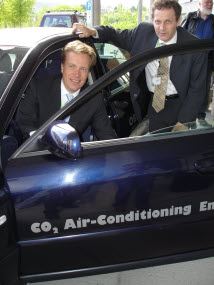
|
|
Norwegian politician Børge Brende tries out the test car, which is fitted with CO2-based air-conditioning. Onlooker Petter Nekså and his colleagues in SINTEF and NTNU developed the vehicle's "green" systems. Photo: Svein Tønseth |
The car is one of a handful of test vehicles that are now out on the roads of Europe, all of them fitted with air-conditioning system that only utilise natural materials.
An alternative to the old chemicals…
Chemicals that break down the Earth’s ozone layer when they leak out have traditionally been used in air-conditioning systems and heat pumps.
Through the 1987 Montreal Protocol, the international community resolved to eliminate such compounds, and the implementation of this protocol was remarkably effective.
Unfortunately, however, the chemical sector chose a solution that brought another problem in its wake.
…and an alternative to the new ones
The chemicals that were launched as replacements turned out to have powerful “greenhouse” effects.
In fact, the situation today is that leakages from air-conditioning systems and heat pumps release greenhouse gases equivalent to around 10% of anthropogenic emissions of CO2 from fossil fuels.
“Back to Nature”
Just around the time when the Montreal Protocol was adopted, Professor Gustav Lorentzen (1915 – 1995) of the present NTNU made history in the refrigeration industry when he called for the use of natural materials as “work-horses” in refrigeration units and heat pumps, rather than new chemicals.
Together with younger colleagues at SINTEF and what is now NTNU, Lorentzen developed a new technology based on this philosophy.
Green gains – with the aid of CO2
The Trondheim scientists decided to use CO2 as a replacement for the chemicals.
This could be regarded as a sustainable solution, because CO2 as used in refrigeration systems and air-conditioning units does not contribute to the greenhouse effect if it leaks out into the atmosphere.
The CO2 is borrowed, as it were, from industrial flue gases which would simply have been discharged in any case.
An effective replacement
The Trondheim research group was the first to demonstrate that CO2 is capable of replacing chemicals in car air-conditioning units without increasing fuel consumption.
SINTEF and NTNU also showed the rest of the world that CO2 can be used in efficient heat-pumps for low-power water heating.
World congress opened by distinguished guest
In May 2006 SINTEF and NTNU hosted a world congress on environmentally friendly refrigeration technology: the “Gustav Lorentzen Conference on Natural Working Fluids” in Trondheim.
The opening speech was given by Børge brende, who in 2003 – 2004 led the UN’s Sustainable Development Commission.
Mr. Brende has also been Minister of Environment and then Minister of Trade and Industry in previous Norwegian governments. He has also been a member of the Norwegian Parliament.
Believes in “implementable” requirements
During a press conference after the opening, Brende pointed out that the refrigeration industry solved an important environmental problem during the 1980s, when the fight for the ozone layer was won.
Now, he believes that the sector can beat the next challenge – to eliminate its discharges of greenhouse gases.
“As long as we impose requirements that can actually be met, the technology that is needed will be developed,” claimed Brende, with a smile on the direction of the Audi.
Industrialised by Hydro
Hydro, a Fortune Global 500 supplier of aluminium and aluminium products, based in Norway, secured the commercialisation rights to the Norwegian CO2 technology.
Hot water for the Japanese
The CO2 technology born in Trondheim has become a hit in the Japanese housing market, where it is used in heat pumps to heat tap-water and indoor air at a low energy cost.
Coca Cola has also announced that it intends to use CO2 technology in its point-of-sale chilling units all over the world.
Test cars with CO2 systems
The CO2 technology could also become part of everyday life for all European motorists.
The EU is currently drawing up a directive that will require all new vehicles from 2011 onwards to have air-conditioning systems that do not contain the chemicals that are in use today.
The number of vehicles in Europe with air-conditioning systems will increase rapidly during the next few years, and unless countermeasures are adopted, the vehicle fleet will increase Europe’s discharges of greenhouse gases.
This is why energy and environment politician Børge Brende is pleased that the dark blue Audi and several similar test cars – all fitted with CO2-based air-conditioning systems – are now on the road.
Proud Trondheim patriot
“ I suppose you will be buying one of these in 2011, then?” asks one of the journalists.
“I would like to have had it today,” smiles Brende, who does not hide the fact that he is proud to hail from the town where it all started.
“We have to take our hats off for SINTEF and NTNU for their achievement in this field,” says Børge Brende.
Read more about the origins of CO2 technology
by Svein Tønseth
